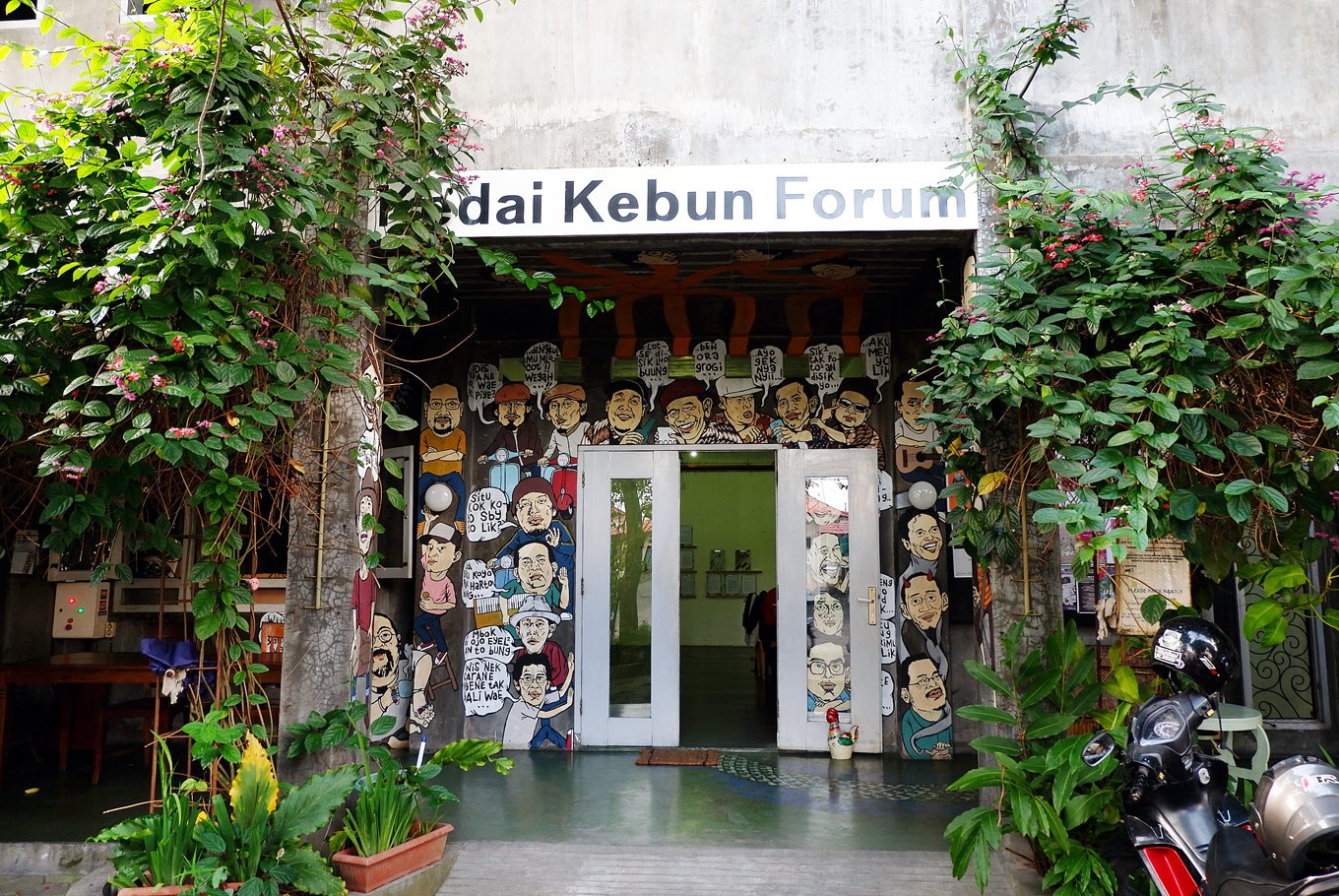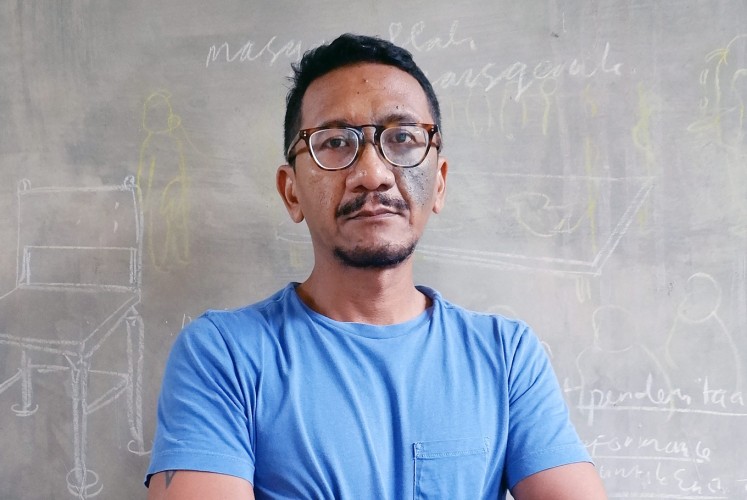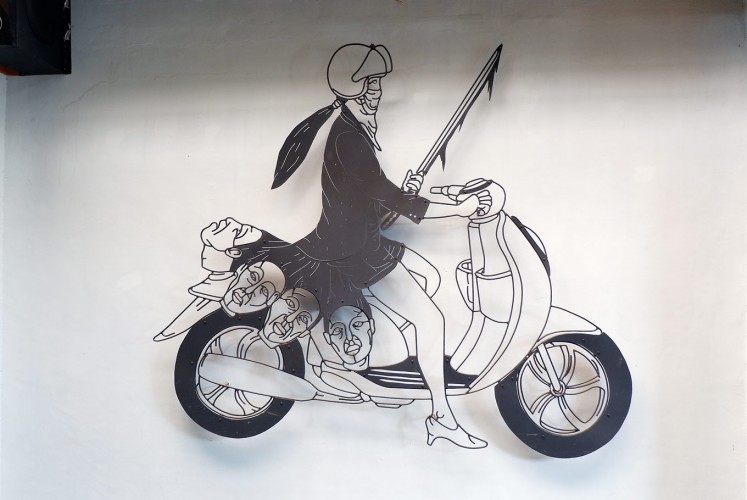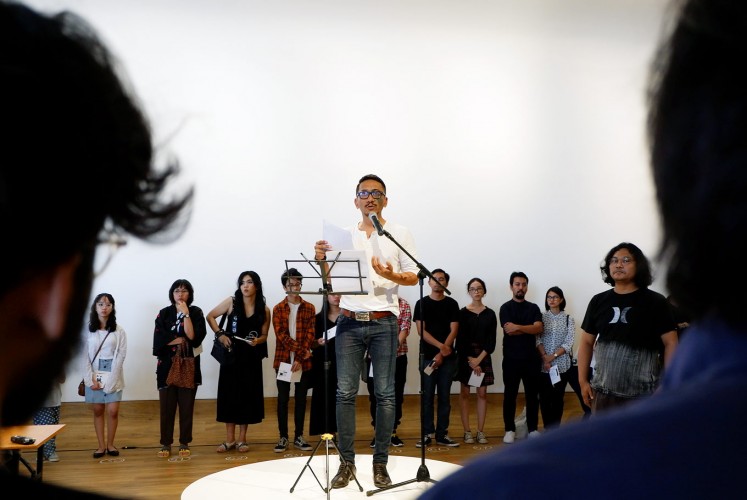Popular Reads
Top Results
Can't find what you're looking for?
View all search resultsPopular Reads
Top Results
Can't find what you're looking for?
View all search resultsAgung Kurniawan: Humanizing humans through art
Artist Agung Kurniawan sees what other people believe is good or bad in a different way.
Change text size
Gift Premium Articles
to Anyone
A
fter studying archaeology for four years at Gadjah Mada University in Yogyakarta, Agung Kurniawan decided to quit in 1991 because he thought it was boring, a decision that shocked his dean and made his mother cry.
“If my mother cried, it meant that her anger was at maximum,” said the tall, lean man with a pipe in his mouth.
His mother was disappointed when he moved to the Indonesian Arts Institute (ISI) in Yogyakarta to learn graphic arts. She thought that if he graduated, he would end up selling paintings on the street.
However, Agung did not graduate because, once again, in 1995 he decided not to finish his studies at ISI. He argued that to be an artist, a university diploma was not necessary.
Being a dropout was his way to prevent anyone from influencing him to be a civil servant or entering other professions that require a graduate certificate.
“Having a certificate gives me many choices. I do not want many choices. I just want to be an artist,” he said. “If I had graduated from ISI, I might be a dean or vice rector now.”
Born 50 years ago in Jember, East Java, Agung walks the talk. He has made a name for himself in the Indonesian contemporary art scene since winning the Phillip Morris Art Award for his painting titled Very, Very Happy Victim in 1996.
Having held 14 solo exhibitions and taken part in over 80 group exhibitions at home and abroad, he is known for playfully and satirically addressing social and political issues.
Agung is the artistic director of Kedai Kebun Forum art space that he and his wife set up in September 1997 on Jl. Tirtodipuran in Yogyakarta. The art space combines a garden, art gallery, bookstore and restaurant.
Agung Kurniawan (JP/A. Kurniawan Ulung)There, he displays his artworks, including a painting-like steel installation titled Happy Hunting Kimchil. At a glance, the work is visually cool, but, upon closer observation, it is a bit disturbing – depicting a long-haired lady riding a motorcycle in hot pants, black jacket and high heels with one hand holding a blood-covered long sword and four men’s heads hanging from her bike seat.
The installation relates to hurtful words, such as kimchil, ciblek and cabe-cabean, to demean women who engage in sexual activity for money.
“I believe that one day, if they gather and want to unite, they will get revenge for all the stereotypes we have given them. Our heads will be hung from their motorcycle seats,” he said.
In August this year, Agung will head to Germany for an artist residency in an art studio for at least six months.
Upon his return from the residency program, he expects to have fresh ideas inspired by new things he finds in that country.
For him, leaving home is his way to get out of his comfort zone to try new things.
“Most Indonesian artists are set in their ways. If they have found their style, they maintain it throughout their life as if they do not want to change,” he said.
Happy Hunting Kimchil by Agung Kurniawan (JP/A. Kurniawan Ulung)Agung himself has switched his main interest from drawing, illustrations and comics to art performances. Today, he is developing a kind of play with a visual script.
The artist is also preparing a new artwork inspired by his five-month residency at rehabilitation center Panti Karya in Yogyakarta where he voluntarily took care of patients with mental illnesses.
What surprised him was that although they were mentally unwell, these patients had compassion, something he said many people may not be aware of. At the rehabilitation center, he witnessed how the patients cared for each other.
“I had more spiritual experiences in Panti Karya than in church,” the artist said.
At the center, he said his unpaid work paid off because he got what he never learnt at school: humanity.
Just like Panti Karya’s patients, survivors of the 1965 tragedy are one of Agung’s biggest inspirations.
In July last year at UGM, Agung staged a play titled Gejolak Makam Keramat(Sacred Grave Unrest) in a bid to heal the traumatic memories of 1965 survivors as well as to make the young generation aware of the tragedy, which he said had structurally and geopolitically changed the face of Indonesia from socialism to capitalism.
For him, the survivors are like his mother. “Every time I work with them I feel that I am working with my mother,” said Agung, who has never been threatened or attacked for supporting the survivors, although the 1965 issue is still taboo.
He also put on a show titled Sri: Sebuah Biografi dalam 65 Kata (Sri: A Biography in 65 Words) in August last year as a pre-opening event at Museum MACAN in Jakarta.
At play: Agung Kurniawan and 65 visitors perform a show dedicated to survivors of the 1965 tragedy at Museum MACAN in Jakarta. (JP/A. Kurniawan Ulung)The show retold the true story of survivor Sri Wahyuni, a famous singer who was jailed without trial for five years for unclear reasons in Semarang, Central Java. She was accused of being affiliated with the Indonesian Communist Party (PKI) as she worked at Melati kindergarten, which was founded by the now-defunct leftist artists association Lekra.
Aged 87, Sri is one of around 20 remaining survivors in Yogyakarta. They have a group named Kiprah Perempuan (Women’s Action), and hold arisan or social gatherings once every two months, in which Agung also participates.
Before finding out about that group, Agung took part in the making of Dunia Milik Kita (The World Belongs to Us) in 2016, the first album of Dialita, a choir made up of the relatives of survivors of the 1965 tragedy.
He said if people deem the 1965 survivors weak, they are wrong. For him, they are wonder women who are mentally and physically strong and they have taught him to not easily give up.
“They have lost their fear. They know how it feels to be beaten, kicked, stripped naked, raped and other horrific things that people are normally afraid of,” Agung said. “They have already been sent to hell, but they managed to get home safely.”
While preparing for his trip to Germany, he is still busy with various workshops and training sessions at Kedai Kebun Forum for people who want to learn art.
“It [the training] is called Sekolah Sore [Afternoon School]. Every year, we hold 11 exhibitions,” the artist said.














